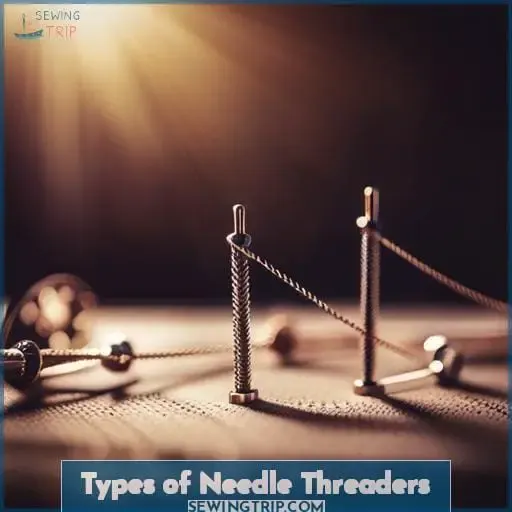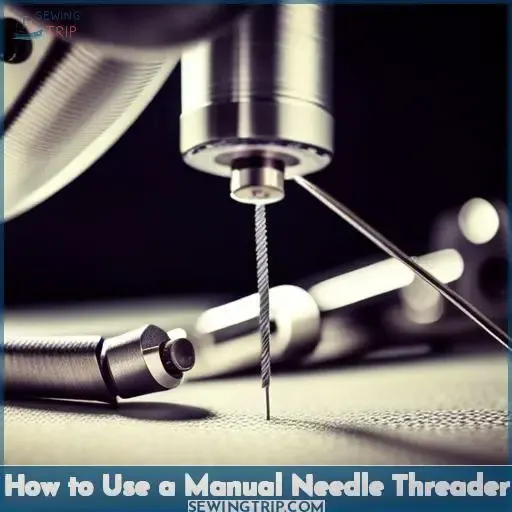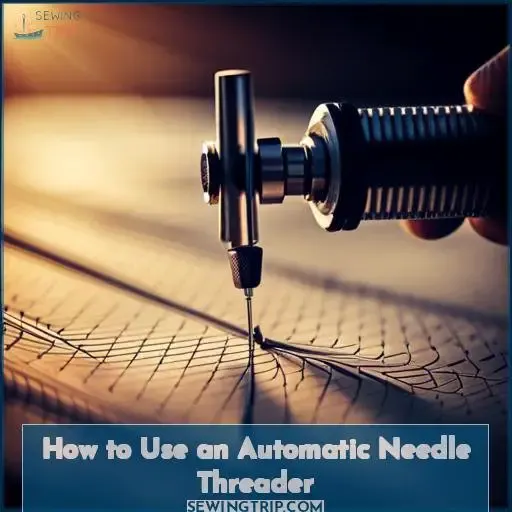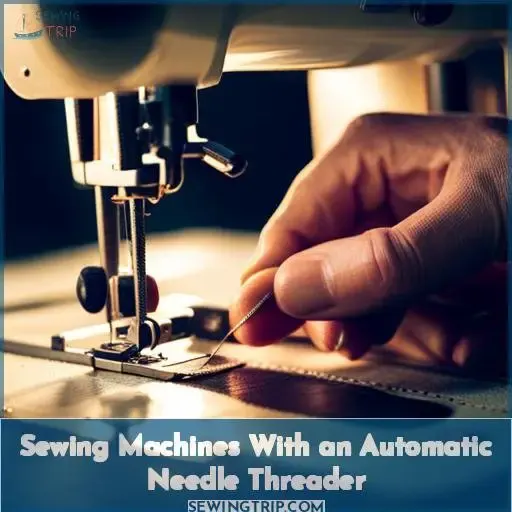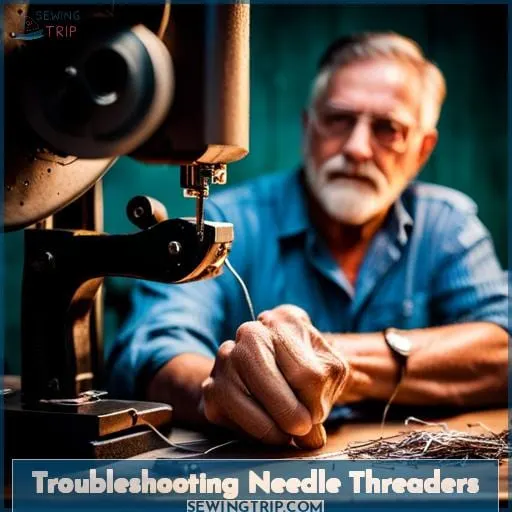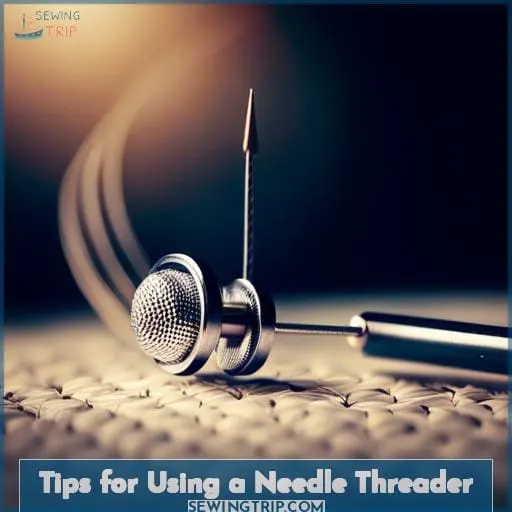This site is supported by our readers. We may earn a commission, at no cost to you, if you purchase through links.
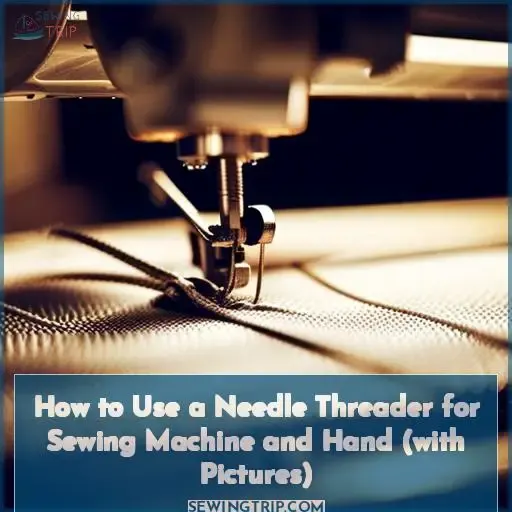 Threading a needle can be tricky, but using a needle threader makes it easy. Follow these steps to thread a needle with a needle threader for sewing machine and hand:
Threading a needle can be tricky, but using a needle threader makes it easy. Follow these steps to thread a needle with a needle threader for sewing machine and hand:
- Insert the needle threader into the eye of the needle.
- Hold the needle threader with one hand and the thread with the other.
- Pull the thread through the eye of the needle with the needle threader.
- Remove the needle threader from the needle.
Threading a needle with a needle threader for a sewing machine is similar to threading a needle by hand.
- The needle threader is inserted into the needle from the back.
- The thread is pulled through the eye of the needle with the needle threader and the machine needle.
- The needle threader is removed from the needle after the thread is pulled through.
Table Of Contents
Key Takeaways
- Insert the needle threader into the eye of the needle.
- Choose a needle threader that matches the needle size.
- For hand sewing, insert the needle threader into the needle from the front.
- When using an Automatic Needle Threader for Sewing Machines: Hold the needle with the eye facing up, insert the hook into the eye, guide the hook through the needle eye, ensure sufficient thread on both sides of the wire loop, and press or flip the button/lever to activate the automatic threading mechanism.
Types of Needle Threaders
There are two main types of needle threaders for hand sewing: manual and automatic.
Manual needle threaders are the most common type.
They’re typically made of metal or plastic and have a wire loop or hook that’s inserted into the eye of the needle.
Automatic needle threaders are less common but can be very helpful for people who’ve difficulty threading needles.
They’re typically battery-operated and have a small hook that’s inserted into the eye of the needle.
How to Use a Manual Needle Threader
Manual needle threaders are fairly simple and straightforward. To use a manual needle threader, follow these steps:
- Use a needle threader that’s the right size for your needle.
- Hold the needle steady with your non-dominant hand while threading it with the other hand.
If the thread is too thick or thin, try using a different thread.
If the needle threader isn’t working, try using a different one.
If you’re still having trouble, ask a friend or family member for help.
How to Use an Automatic Needle Threader
To use an automatic needle threader, hold the needle with the eye facing up and insert the hook into the eye.
Here’s how to use it effectively:
- Gently guide the hook through the eye of your sewing machine or hand sewing needle.
- Make sure that you have a sufficient amount of thread extending from both sides of the wire loop.
- Press or flip a button/lever to activate the automatic threading mechanism.
- Watch as your needle is automatically threaded in seconds.
The benefits of using an automatic needle threader include:
- Saving time
- Reducing frustration when threading needles, especially for those with poor eyesight or limited dexterity.
However, there are some drawbacks worth noting:
- Automatic threaders may not work well with very thin needles and small eyes.
- Some models can be flimsy and prone to breaking.
If you encounter issues with your automatic needle threader, check if any parts are bent or ensure compatibility between different types of needles and threads used on them.
Sewing Machines With an Automatic Needle Threader
If your sewing machine has an automatic needle threader, you can easily thread the needle with the push of a button.
| Type of Sewing Machine | Benefits | Drawbacks |
|---|---|---|
| Mechanical | Threading the needle is quick and easy. | The needle threader can be difficult to use on some machines. |
| Electronic | Threading the needle is quick and easy. | The needle threader can be expensive. |
| Computerized | Threading the needle is quick and easy. | The needle threader can be very expensive. |
Troubleshooting Needle Threaders
Experiencing issues with your needle threader? Check the following aspects to troubleshoot common problems and ensure seamless sewing experiences:
- Threader Maintenance: Make sure that your needle threader is clean and free from any debris or lint buildup. Regularly clean it using a soft brush or compressed air to prevent clogs.
- Common Issues: If you’re encountering difficulties with your needle threader, check for bent wire loops or hooks, as they can affect its functionality. Replace any damaged parts promptly.
- Needle Compatibility: Ensure that you’re using the correct size of needles compatible with your needle threader. Using needles that are too thin may cause difficulty in threading.
Remember to practice proper user techniques when utilizing a needle threader, such as holding the tool securely and positioning it correctly relative to the eye of the needle.
If troubleshooting doesn’t resolve the issue, consider alternative methods like hand-threading or seeking professional assistance for repairs or replacements.
Tips for Using a Needle Threader
For smoother sewing experiences, regularly practice using a needle threader to enhance your threading proficiency.
-
Needle Threader Maintenance:
- Keep your needle threader in good condition by cleaning it regularly.
- Remove any lint or debris that may accumulate, ensuring smooth operation.
-
Threading Hacks:
- If you’re struggling to thread a particularly fine needle, moisten the thread slightly to make it more manageable for the needle threader.
-
Choosing Needle Threaders:
- Select a needle threader that suits your needs.
- Consider factors such as the type of needles you frequently use and whether a manual or automatic threader would be more convenient for your projects.
-
Threader Alternatives:
- In a pinch, if you don’t have a needle threader, try using a contrasting color of thread to guide your main thread through the needle’s eye.
-
Needle Safety:
- Always be mindful of the needle’s pointed end.
- Keep your fingers at a safe distance to avoid accidental pricks during the threading process.
Frequently Asked Questions (FAQs)
Can a sewing threader be used for both hand and machine sewing, or are there specific threaders designed for each type of sewing?
Yes, a sewing threader can be used for both hand and machine sewing.
Designed for convenience, these tools help effortlessly thread needles, whether for delicate hand stitches or machine projects.
Are there any specific precautions or tips for using a sewing threader with heavy or metallic threads to avoid fraying issues?
When working with heavy or metallic threads, ensure your sewing threader’s hook isn’t bent. Avoid using it for these threads, as they may fray. Choose the right tool for your thread and keep your sewing experience frustration-free.
How can one differentiate between a bent needle and a malfunctioning automatic needle threader when troubleshooting threader issues?
To differentiate between a bent needle and a malfunctioning automatic threader, inspect the needle for any bends or damage. If the needle appears fine, focus on troubleshooting the threader by checking its hook for bending or misalignment.
Do all sewing machines come with a built-in needle threader, or is it a feature found only in specific models?
Not all sewing machines come with a built-in needle threader. It’s a feature found only in specific models.
Make sure to check the specifications of your machine before purchasing if this is an important feature for you.
Are there any limitations to the sizes of needles that can be effectively threaded using a particular type of needle threader, such as the silver wire loop needle threader mentioned in the article?
When using a needle threader, keep in mind that certain types may have limitations when it comes to threading smaller needles.
Consider the metaphor of a key fitting into different locks – not all threaders are compatible with every needle size.
Conclusion
Embarking on your sewing journey is now smoother with the art of needle threading demystified. From manual to automatic threaders, this guide has unveiled the secrets of seamlessly weaving your thread through the needle’s eye by hand or using a sewing machine.
Embrace the convenience of this essential tool, and let your creativity thread effortlessly through fabric, transforming your projects into seamless masterpieces.

